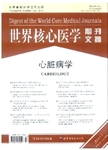无冠心病的患者中肥胖与左室重构、舒张功能异常的关系
Association of Obesity With Left Ventricular Remodeling and Diastolic Dysfunction in Patients Without Coronary Artery Disease作者机构:Division of Cardiovascular Diseases Mayo Clinic Rochester MN United States Dr.
出 版 物:《世界核心医学期刊文摘(心脏病学分册)》 (Digest of the World Core Medical Journals(Cardiology))
年 卷 期:2006年第2卷第11期
页 面:37-38页
主 题:舒张功能异常 左室重构 心室重构 舒张期末容积 冠状动脉造影 室壁厚度 左室结构 室壁应力 呼吸困难
摘 要:Obese patients frequently complain of dyspnea. Deconditioning and altered left ventricular(LV) systolic or diastolic function with elevated filling pressures may contribute to dyspnea. This study analyzed 4,281 patients who underwent diagnostic coronary angiography from January 1, 1995, to December 31, 2000. No patients had coronary artery stenoses 50%of the luminal diameter, and all underwent echocardiography within the same 6-year period. The association between body mass index(BMI) and LV structure and systolic and diastolic function was examined. All analyses controlled for age and gender, with the effect size for BMI expressed using a standardized coefficient(SC). A higher BMI was associated with greater LV mass(SC 0.18, p 0.001), wall thickness(SC 0.17, p 0.001), and end-diastolic diameter(SC 0.07, p 0.001). Stroke volume increased with a higher BMI(SC 0.12, p=0.001), but there was no association between BMI and the ejection fraction(SC 0.003, p=0.81). Hemodynamic data from invasive studies showed an association between a higher BMI and increased LV end-diastolic pressure(mean 17 mm Hg for BMI 25 kg/m2 vs 24 mm Hg for BMI ≥40 kg/m2; SC 0.18, p 0.001), which persisted after controlling for end-diastolic volume(SC 0.22, p 0.001). Obesity was associated with ventricular remodeling, which may normalize wall stress while increasing stroke volume to match metabolic demand. Obesity was not associated with decreased systolic function. However, obesity was associated with increased LV end-diastolic pressure, which suggests an association between obesity and diastolic dysfunction. In conclusion, ventricular remodeling, LV diastolic dysfunction, and elevated filling pressures may contribute to the prevalence of heart failure in obese patients.



